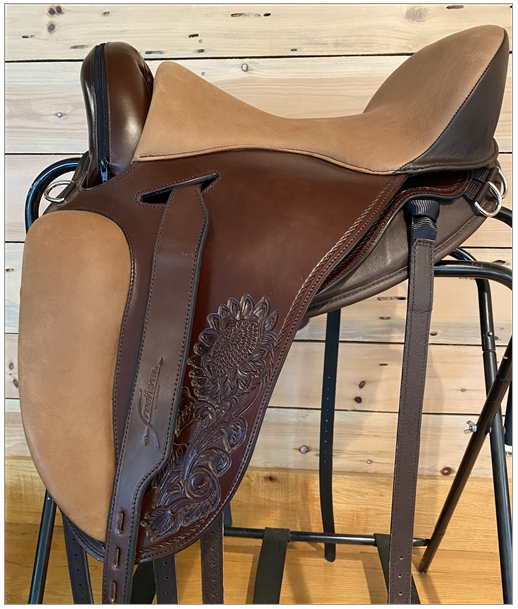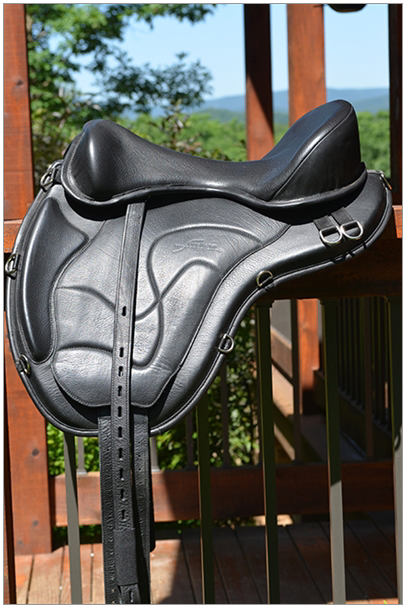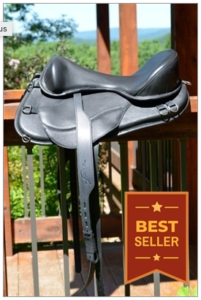
Freeform saddles come in many different styles to suit various disciplines. Shown here is the Freeform Pathfinder PJ.
By Susan Kauffmann
I am a real stickler about saddle fit. I was forced to become knowledgeable in this area when my morgan, Gryphon, outgrew the lovely Rodrigo Pessoa Gen X jumping saddle I started him in. It had fit him fine when he was a three year old, but as he filled out through the back and shoulders, he became quite wide in that area and my beloved saddle just didn’t work anymore. We went through several saddles over the years, as he kept changing shape and I kept changing disciplines (went from jumping to dressage to rugged trail riding). It was ALWAYS a nightmare trying to find a treed saddle that would work for him, and when something didn’t work for Gryphon, he told you ALL about it by bucking, various airs above the ground, etc. So, once I decided that trail riding was going to be my main activity, I sold my custom made dressage saddle (that had cost me twice as much as my horse!) and decided to go treeless.
What I have learned in the ensuing years is that not all treeless saddles are created equal — not by a long shot! Some are little more than glorified bareback pads, providing no support for the rider and doing little to distribute the rider’s weight over the horse’s back. I tried many and bought a couple before finally finding my “dream saddle”, meaning one that is beautifully made, distributes weight very well, and is extremely comfortable for both me and my horses. What is this amazing saddle, you ask? The Freeform treeless, made by Le Selle Italiene in Italy. While they have many styles for different disciplines, my favorite is the Classic, but I have also bought a Freeform western style saddle for my husband, and it is wonderful.
Here are some specifics about why I truly love Freeform saddles:
- The leather is beautiful, and the craftsmanship is top notch.
- While they are not cheap, for a saddle of this quality, the price is very reasonable.
- These saddles are designed to distribute the rider’s weight very well. Everything from the underlay to the girthing system contributes to this quality — very important in a treeless saddle. It becomes even more important if you are a heavier rider like my husband, who is 6’2″ and 200 lbs.
- I feel really balanced in these saddles, in part because of the completely adjustable stirrup position. The stirrups can be moved as far forward or as far back as you like by simply lifting up the seat (which velcros on) and moving the part that the leathers attach to. The model I am now riding in also has adjustable knee blocks, and the seats on most models can be moved forward and backwards as well.
- The saddles are incredibly comfortable. I struggle with chronic pain issues in my back, neck, knees and hips, and I can ride much longer in a Freeform saddle than in any other, by far.
- I feel extremely secure in my saddle, no matter how steep the terrain or how rowdy the horse. I have stayed on some epic spins and bucks in my Freeform and felt that it really helped me keep my seat.

This is the Freeform Classic, very similar to the one I now ride in.
- They can be made to fit just about any horse. I’ve now had Freeform saddles on my Morgan; my big-shouldered APHA; a wee Welsh pony; a broad, flat and short-backed mustang, and my new Paint/Friesian cross, and they have worked beautifully on all of them. The horses move well, do not get sore, and seem relaxed and happy in the Freeform saddles. There are different models that may be more suited for a particular build, but in general, adjustments can be made to the padding if needed and you are good to go.
- Freeform has so many really cool options — like the fact that you can order different sized seats and use the same saddle for different sized riders.
- These saddles are really popular with Endurance riders, including a number of Tevis Cup winners. I always figure if something works for the endurance crowd, it works, as nobody puts more demands on a horse and saddle than those folks, and their backs are checked regularly for soreness during every race. There are even some “heavyweight” class endurance riders doing very well in the Freeform saddles — a testament to the excellent weight distribution this brand provides.
- The gal who sells Freeform saddles in the USA, Paulita Neff, is kind, caring, and awesome to work with. She is extremely knowledgeable and bends over backwards to make sure you get the right saddle with the right accessories, that everything fits properly, and that you are happy with your purchase. She also won’t try to “sell you” something, as she truly wants what is best for the horse. You can contact Paulita here, at TreelessSaddle.com.
There are a couple of points to be aware of with Freeform saddles, which I would say apply to most if not all other treeless saddles:
- Personally, I would not do any real jumping in a treeless saddle. Though the balance of the Freeform is terrific, I do not feel that any treeless saddle can really distribute the impact forces generated when a rider in a two-point takes a landing off of a big fence. Your weight can come down pretty hard in your stirrups at that moment, even though you should be taking some of that load through your calf and lower thigh contact. I’ve hopped over the odd obstacle on the trail and have no problem with that, but that’s about all I would do.
-

“The Ultimate Trail Saddle” is one of Freeform’s top sellers. It is light, comfortable, and has a secure seat that can help you feel your best on those long rides.
The Freeform, like many treeless saddles, requires that you use a special pad with inserts that slip into special pockets. The inserts create a channel for the horse’s spine. Some treeless saddles do have a channel built in, but the inserts have the advantage of being customizable. My morgan’s spine, for example, was very wide — and I mean the actual bone column. I was able to easily adjust for this by trimming the inserts in his pad. You can also swap the inserts out if they wear down or if you decide you need something different in there.
- Treeless saddles can tend to roll more than treed saddles. The Skito brand pad I use has real sheepskin underneath, which help prevent slippage, but I still prefer not to mount from the ground unless I absolutely have to. Other riders have mounted from the ground in my saddle and it hasn’t slipped, but they are young and spry and strong, while I am not! I prefer using a block whenever possible, as it is easier on my body AND it puts less torque on the horse’s back. This has been proven in studies — mounting from the ground can make your horse sore!
So, if your horse is hard to fit, has back issues, or you simply want both you and your horse to experience a new level of comfort, check out the Freeform treeless options. I think you’ll be happy you did. : )
Like this article? Leave us a comment below, and be sure to click “subscribe” at the bottom left of this page to make sure you don’t miss upcoming articles!